Online Backgammon Dictionary
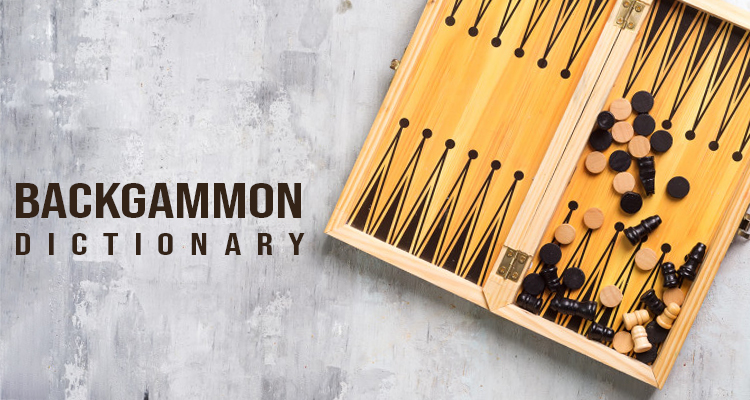
04:09 Jul 17th, 2018 Games Online Gambling
A.B.T.
- A.B.T. is the abbreviation for the American Backgammon Tour which is a group of backgammon players and clubs that regularly hold tournaments.
Ace Point
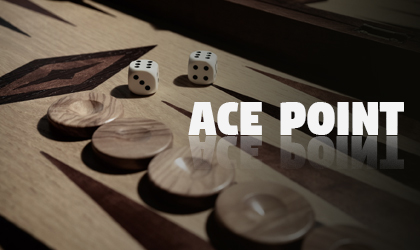 - A backgammon players ace point is the number one point on their home board.
- A backgammon players ace point is the number one point on their home board.
Ace Point Club
- The Ace Point Club is a very popular backgammon gambling club that can be found in New York City, New York in the United States.
Ace Point Game
- An ace point game is a game where a player has a made point in their opponents home board while they are bearing off. The only possibility of winning at this point is to hit a blot before they can bear off all of their checkers.
Acey Deucey
- Acey Deucey is a variation of backgammon in which a roll of one and two is allowed to be a double of the players choice as well as an extra roll of the dice. Acey deucey is also a backgammon reference to a roll of one and two.
Across
- Across is a reference in backgammon play to moving from any one of the four quadrants or boards to another.
Action Play
- Action play is a backgammon reference usually describing a type of backgammon play where a player will induce an exchange of hits after their opponent has brought in their runners.
Action Position
- An action position is a backgammon reference to a position in a backgammon game in which a player offers a double, primarily because of the immediate potential for hitting blots.
Active Builder
- An active builder is a backgammon checker that is free and able to assist in making points.
Advanced Anchor
- An advanced anchor is a made point on your opponents four or five point. Strategically the advanced anchor is an important anchor to avoid having ace point anchor primed.
Ahead
- Ahead (ahead in the count or race) refers to having a lower pip count than your opponent.
Air Ball
- Air ball is a backgammon reference to a poor roll of the dice.
Analog Clock
- An analog clock is a traditional chess clock that measures each players time. Analog clocks do not have a time delay feature however and this makes them less desirable for use in backgammon playing.
Anchor
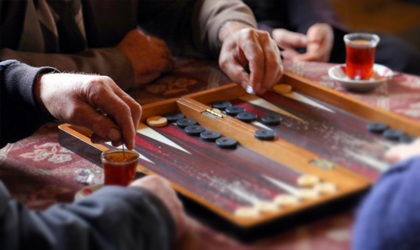 - An anchor is a made point or a point that is occupied by two or more checkers.
- An anchor is a made point or a point that is occupied by two or more checkers.
Annotated Match
-An annotated match is a backgammon game that is recorded and analyzed with commentary.
Annotation
- Annotation is analysis as well as commentary about a backgammon game, compiled after the game has been played.
Anti-Joker
- An anti-joker is backgammon slang for a very bad roll or the opposite of a joker.
Army
- A backgammon players army is referring to the way the players checkers work together attacking and blocking against the enemy or opponent until you bring them home safely.
Around The Corner
- Around the corner is a backgammon reference to a move of a players checkers from their opponents outer board to their own outer board.
Asset
- An asset for a backgammon player is a reference to the good side of their position. For example, made points are an asset as is having the ability to move all of your checkers.
Attack Game
- An attack game is the same as a blitz which is a very aggressive and generally short game.
Automatic Doubles
- Automatic doubles are an option that many backgammon players use when playing backgammon for money. In backgammon money play with automatic doubles, the doubling cube would automatically be turned to two and stay on the bar in the event that both players roll the same number when rolling the first roll of the game. Generally players will limit the number of automatic doubles per game, usually to one.
Automatics
- Automatics is a reference to automatic doubles in backgammon.
Awkward Number
- An awkward number is a backgammon roll that forces the player to break up a valuable made point or miss a shot.
Back Game
- Backgame is a common backgammon strategy where a player remains somewhat behind in the game but has one or two strategically placed anchors in the opponents home board aiming at making a hit while the opponent is bearing off, trapping them behind a prime or closed board. This is referred to as a holding game.
Backgammon
- Backgammon is a board game played with dice and checkers. Backgammon is also a reference to a completed game of backgammon when the winner of the game has done so before their opponent has borne off any of their checkers and they still have a checker on the bar. The loser was backgammoned.
Backgammon Board
- The backgammon board that the game of backgammon is played on. A backgammon board is comprised of twenty-four long triangles that are called points. These points are divided into four quadrants, each containing six points. These quadrants are referred to as the players home board and outer board and the opponents home board and outer board. A raised ridge that runs down the middle of the backgammon board divides the home boards and outer boards. This ridge is called the bar.
Backgammon Server
- A backgammon server is the computer that operates a backgammon site on the internet. The backgammon server runs software that allows users to log on from anywhere in the world and play backgammon with other backgammon players, often for money.
Back Man
- A back man is a players farthest out or from home checker, also referred to as a runner.
Baffle Box
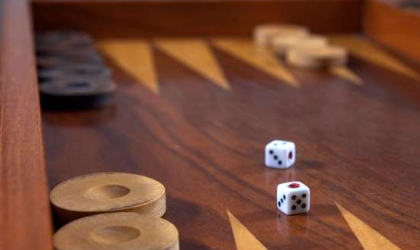 - A baffle box is a mechanism that backgammon players drop the dice thru in order to ensure that the dice roll is completely random. As the dice fall thru the baffle box they are bounced about before falling out and rolling.
- A baffle box is a mechanism that backgammon players drop the dice thru in order to ensure that the dice roll is completely random. As the dice fall thru the baffle box they are bounced about before falling out and rolling.
Banana Split
- A banana split is backgammon slang for breaking a point in your home board leaving two checkers exposed and vulnerable to being hit.
Bar
- The bar on a backgammon board is the raised surface that divides the home boards and outer boards. When a checker has been hit, it is placed on the bar and must be brought back into the game before any other checkers can be moved.
Barabino
- Barabino is backgammon slang for rolling a five and four from the bar and using it to make a point on your opponents five point. This roll is named after Rick Barabino, backgammon expert.
Bar Point
- The bar point in backgammon is the seven point. The seven point is called the bar point because it is physically next to the bar on the backgammon board.
Battle of Primes
- A battle of primes is when both players have checkers that are trapped behind their opponents primes. This is also called Prime vs. Prime.
Bear In
- Bearing in is a reference to moving your checkers into your home board in preparation for bearing off.
Bear Off
- Bear off refers to the player removing their checker from their home board during the bearoff in the final stage of the game.
Bearoff
- The bearoff is the final stage of the game when the players are removing their checkers from their home board.
Bear On
- Bear on is backgammon lingo for being within six points from your home board.
Beaver
- A beaver is a doubling move used when both players agree to use it where a player may immediately redouble and retain possession of the doubling cube.
Beavers
- Beavers is a variant of backgammon sometimes used in money play whereby a player who is offered a double may immediately redouble without giving up possession of the doubling cube.
Behind in the Count
- Behind in the count is a reference in backgammon for having pore pips than your opponent. Pips are the spaces the checkers must be moved in order to bring them home and bear them off. This is also referred to as behind in the race.
Bertha
- Bertha is backgammon slang for playing the roll of six and five from your opponents one point to your midpoint without realizing that your opponent has already made his bar point and blocks your way.
B.I.B.A.
- B.I.B.A. is the abbreviation for the British Isles Backgammon Association.
Big Play
- A big play is a backgammon term used to mean a very aggressive or bold move that is made when a much smaller play was available.
Binache
- Binache is the same thing as beavers which is a style of backgammon play commonly used when playing backgammon for money that allows a player who has been offered a double to immediately double again while still keeping the doubling cube.
Blitz
- A blitz is a very aggressive attack on your opponents blots in an attempt to close your opponent out. A blitz is also a form of quick elimination tournament play.
Block
- A block is a point that is occupied by two or more checkers whose purpose is to hinder the progress of their opponent.
Blockade
- A blockade is a series of blocks whose purpose is to make your opponents runners difficult to escape.
Blocking Backgammon
- Blocking backgammon is a backgammon variant in which single checkers on a point occupy that point.
Blocking Game
- A blocking game is a backgammon playing strategy where the primary objective is building a strong blockade.
Blot
- A blot is a single checker on a point. Blots can be hit by the opponent at which time they are placed upon the bar and must be brought back into the game before any other checkers can be moved.
Blot Hitting Contest
- A blot hitting contest is a reference to an exchange of hits by each player in an attempt to secure a key point.
Blunder
- A blunder or a whopper is a significant move that was made in error usually due to recklessness or inattention.
Board
- Board in backgammon is usually a reference to the backgammon board itself or one of the four quadrants.
Board Layout
- The board layout is a reference to the way in which the checkers are arranged at the start of the game. This is also referred to as the board setup.
Bold Play
- A bold play in backgammon is usually a play in which the player leaves one or more of his blots exposed and in danger of being hit.
Bold-Safe Criteria
- Bold-safe criteria is the same as safe-bold criteria which is a list of six criteria that are used for determining whether or no to make a bold move or a safe move in any given situation. Paul Magriel is credited for compiling this list of criteria in his book, Backgammon.
Book a Checker
- To book a checker is the same as covering a blot which is to add a checker to a blot, thus making that particular point.
Box
- Box is a shortened reference to man in the box which is a backgammon reference to a player in a very challenging position.
Boxcars
- Boxcars is backgammon slang for a roll of double six also known as boxes.
Boys
- Boys or the boys is another reference to a roll of double sixes.
Break
- Break is a backgammon reference to taking down made points or primes.
Break a Point
- To break a point is to remove the second checker in a made point thus leaving that point exposed to a hit.
Break a Prime
- To break a prime in backgammon a player removes checkers from one or more points in a prime.
Break Contact
- Breaking contact occurs when both players have past each others checkers eliminating the possibility of hitting and the game becomes a race to see who can bear off all of their checkers first.
Break Your Board
- Breaking your board is a reference in backgammon to opening one or more of your made points of your prime in your home board.
Broken Prime
- A broken prime is an incomplete prime.
Bronstein Clock
- A Bronstein clock is a chess clock that has a time delay feature which makes it ideal for backgammon play.
Builder
- A builder is backgammon lingo for a checker that is brought into your outer board and placed strategically onto one or more of your key points.
Build Your Board
- Build your board refers to making points in your home board in an effort to secure it or close it with a prime.
Bump
- Bump is another backgammon term for hitting a checker.
Bump and Pass
- Bump and pass is another way of saying pick and pass or bump and run in backgammon which is to hit an opponents blot and then continue that same checker on to make another point or otherwise safety.
Bury a Checker
- To bury a checker means to place that checker deep within your home board on the one or two point where it has no defending power.
Busted Back Game
- A busted back game is a backgammon game where a backgame strategy failed and forced the player to bury their checkers.
Button Up
- To button up is to move a backgammon checker to another blot securing that point and the safety of the checkers.
Bye
- A bye in backgammon is awarded in tournament play when there is a need for the advancing players to be in multiples of two. A bye is a free advance to the next round in the tournament without having to compete. This usually happens in the first round of the tournament.
Calcutta Auction
- A Calcutta auction is a lottery of entries into a backgammon tournament whereby the players are auctioned off in groups to form a pool which is distributed to the buyers of the winning groups or players.
California Rule
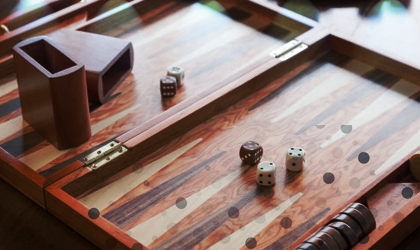 - The California rule is an optional rule that allows the winner of the first roll to re-roll the dice if they turn the doubling cube to two. The doubling cube stays on the bar.
- The California rule is an optional rule that allows the winner of the first roll to re-roll the dice if they turn the doubling cube to two. The doubling cube stays on the bar.
Candlesticks
- Candlesticks is a reference to players positions on the backgammon board where their checkers are stacked high on only a few points.
Captain
- The captain is the leader of the team in a chouette who rolls the dice and makes the final decisions for the rest of the team.
Cash a Game
- To cash a game means to offer a double when you believe it will be refused forfeiting the game and winning you the stakes on the game.
Cast
- Cast means to throw the dice in backgammon.
Catchers
- Catchers are a players checkers that have been spread out on purpose with the intent on hitting the opponents runners.
Centered Cube
- A centered cube is a reference in backgammon referring to the starting position of the doubling cube which is on the bar between the two players with the number sixty-four showing. This means that the current stakes of the game are one.
Chase
- To chase in backgammon means to play dangerously or recklessly in an attempt to recover losses from playing.
Checker
- A checker is any one of the two sets of fifteen disks or markers used in backgammon to move around the board according to the roll of the dice.
Checker Play
- Checker play refers to the act of moving one’s checkers around the board according to the numbers rolled by the dice.
Chequer
- Chequer is the British spelling of checker.
Chouette
- A chouette is a form of backgammon where three or more players can play. One player is the box, which controls one board while the other players form a team with a captain.
Cinque Point
- Cinque point is the traditional backgammon term referring to the five point.
Claim a Game
- Claim a game is the same as cash a game in which a player offers a double believing it will be refused thus forfeiting the game and winning them the money staked on the game.
Clean Play
- Clean play refers to a backgammon move that was performed legally.
Clear a Point
- To clear a point is a backgammon reference meaning to move all of the checkers off of that point.
Clear From The Rear
- Clear from the rear is a backgammon phrase meaning to bear off the checkers on the highest points first in order to avoid creating gaps that hinder the bearing off process.
Close a Point
- To close a point in backgammon means to place one or more checkers onto a point thus preventing your opponent from landing there.
Closed Board
- A closed board in backgammon is when a player has made their first six points creating a prime in their home board.
Closed Point
- A closed point is any point that a player has placed two or more of their checkers thus preventing their opponent from landing there.
Close Out
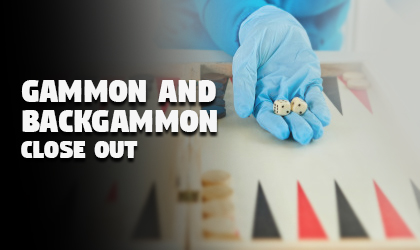 - A close out in the game of backgammon occurs when a player has made a prime in their home board while putting their opponents checker on the bar making it impossible for them to bring them back in until you have broken up your prime.
- A close out in the game of backgammon occurs when a player has made a prime in their home board while putting their opponents checker on the bar making it impossible for them to bring them back in until you have broken up your prime.
Cluster Count
- Cluster counting is a method developed by Jack Kissane, backgammon expert from New York where a player can easily determine the pip count at any given time in a backgammon game.
Cocked Dice
- Cocked dice are dice or a die that has landed either not flat or not on the players right hand board. In the event of cocked dice the player rolls again.
Cock Shot
- A cock shot is backgammon slang for entering from the bar on a roll of six-two and landing on a blot on the eight point when the only open point was the two point.
Combination
- A combination reference in backgammon usually refers to a single checker being used for both numbers on the dice.
Combination Shot
- A combination shot is a move of one checker using both numbers on the dice used to make a hit.
Combinations of the Dice
- Combinations of the dice is a backgammon reference meaning out of thirty-six rolls of the dice, the number it takes to accomplish a particular objective.
Comeback Shot
- A comeback shot is an opportunity to hit an opponents blot immediately after being hit yourself. This is usually in reference to a shot from the bar.
Come In
- Come in means to move a checker from the bar on the backgammon board into your opponents home board.
Comfort Station
- The comfort station is backgammon slang for the thirteen point or the mid-point.
Committed Position
- A committed position in the game of backgammon is a position in a game where there is only one reasonable course of action that may win the game as opposed to a non committed position in which you have game flexibility to make strategic decisions.
Communicate
- To communicate in backgammon is lingo for keeping your checkers within six points of one another so as to provide support and protection to one another.
Compact Position
- A compact position in backgammon is a position on the board in which a player has several made points within close proximity with very few gaps.
Confidence Interval
- Confidence interval is a range of values containing a rollouts convergence value.
Connected Position
- A connected position is a position in backgammon play in which a player keeps all of their checkers within close proximity of one another.
Connectivity
- Connectivity in backgammon is a reference to the degree in which a player has kept a closed position.
Consolidate
- Consolidate is a backgammon reference used to mean the act of reducing the number of blots they have.
Consultation
- A consultation is the advice or recommendations offered to the captain of the team by the crew in a chouette backgammon game.
Contact Position
- Contact position is a position in the game of backgammon when the two players have yet to move past one another and there is still the potential for blocking and hitting.
Contain a Checker
- Contain a checker is a phrase used in the game of backgammon meaning to trap, block or hit the opponents checker impeding its progress or sending it back.
Control a Point
- Controlling a point in backgammon means that a particular point has been made or has two or more checkers on it.
Control the Cube
- To control the cube is the same as owning the cube meaning that only that player may offer a double. The doubling cube starts in the middle of the bar and the first person to offer a double gives the opponent possession of the cube.
Convergence Value
- Convergence value is a value in backgammon that is approached as the dice are rolled more and more times.
Correspondence Games
- Correspondence games are backgammon games played by mail.
Count
- Count is a reference in backgammon to the pip count.
Counter
- Counter is backgammon slang for the backgammon checker.
Counterplay
- Counterplay in backgammon is switching from an offensive position to a defensive position and visa versa.
Count the Position
- Count the position refers to calculating the players pip count to determine who is farther along in the race.
Coup Classique
- Coup Classique is a specific type of win in which a player has a checker on the opponents one point and the opponent has borne off all but three checkers and the player manages to make a hit trapping the opponent on the bar and winning the game.
Cover a Blot
- To cover a blot in backgammon means to add a second checker to a point with only one checker thus making that point.
C.P.W.
- C.P.W. is the abbreviation for cubeless probability of winning which means the odds of winning a backgammon without the doubling cube and it is also referred to as game winning chances.
Cramped
- Cramped means that a backgammon player has few moves of their checkers that they can make.
Crawford Game
- A Crawford game is a backgammon game in match play that immediately follows any game when any player comes within one point of winning the game. The doubling cube is not used in the Crawford game but resumes use in the next game that follows.
Crawford Rule
- The Crawford rule is a standard rule in match play during a tournament that states that the game following any game when either player comes within one point of winning will not use the doubling cube. The doubling cube is active again in the next game.
Crew
- In a chouette backgammon game, the crew are the members of the team who play with the captain against the box.
Crossover
- A crossover is a backgammon checker movement from one quadrant of the board to a board adjacent to it.
Crossover Count
- A crossover count in backgammon is the total number of crossovers that are required in order to get all of your checkers to your home board and borne off.
Crunch
- In backgammon, a crunch is when a player has been forced into moving points from valuable positions because of a lack of other available moves.
Crunched Position
- A crunched position is a board position in backgammon when a player has been crunched deep within their home board with checkers trapped in the opponents home board.
Crunching Position
- Crunching position is a phrase used in backgammon to describe a priming game in which one side is about to collapse but has yet to do so.
Cube
- Cube is a reference to the doubling cube in backgammon.
Cube Action
- A cube action is any one of the potential cube decisions associated with a given position.
Cube Decision
- A cube decision is one of the following choices a player in a game of backgammon must make regarding the doubling cube. The option of offering a double or not and the choice of accepting a double, refusing it, or if the game calls for it, potentially beavering.
Cubeful Equity
- Cubeful equity is the absolute value in backgammon money play, of a players position compared to the initial stake being played for. Cubeful equity in match play corresponds to the probability of winning a backgammon match from whatever the current position is. Cubeful equity must consider the potential for future doubles, the value of the cube and cube ownership.
Cubeful Rollout
- A cubeful rollout is a simulated set of trials by a computer simulator with the doubling cube in play.
Cube Handling
- In backgammon, cube handling is a term describing the art or skill of making appropriate cube decisions.
Cube in the Middle
- Cube in the middle is a term meaning that the doubling cube is still in the middle of the bar and neither player has ownership meaning that either of the players can offer a double at the beginning of their turn. This is also called centered cube.
Cubeless Equity
- Cubeless equity is the number value associated with a particular position in a backgammon game that is played without a doubling cube. This determines the probability of all wins and losses.
Cubeless Probability of Winning
- Cubeless probability of winning is the chance of winning a game of backgammon if a doubling cube is not used. This is also called the game winning chances.
Cubeless Rollout
- A cubeless rollout is a simulated set of trial rolls thru whole games performed by a computer simulating backgammon games with no doubling cube use.
Cube Ownership
- Cube ownership in backgammon refers to the player who last accepted an offer to double the stakes of the game. The player who accepts the offer takes possession of the doubling cube and in the only one who can double the stakes again.
Cube Play
- Cube play is another term for the act of offering, accepting or refusing doubles as well as the skill of making these cube decisions.
Cube Proxy
- A cube proxy is a person who temporarily handles the cube for a backgammon player in a game of chouette while that player is away from the game.
Cube Reference Position
- A cube reference position is a backgammon board position in which the correct cube decision is known thus serving as an example to which other similar positions may be compared.
Cup
- A reference to a cup in backgammon is in regards to the dice cup.
Current Stake
- The current stake in a backgammon game is the initial stake or starting stake multiplied by the doubling cube value.
Dance
- Dance is backgammon lingo for rolling numbers that do not bring the player in from the bar.
Dead Checker
- A dead checker is a players checker that is buried deeply in their home board where it is of no use in the action of the game.
Dead Cube
- A dead cube is a doubling cube that no longer contains any doubling power like when the player in possession has no reason to double.
Dead Man
- A dead man is the same as a dead checker which is a checker that is buried in the home board.
Dead Number
- A dead number is a number on the dice in backgammon that cannot be played by that player in the particular position they are currently in.
Decline a Double
- To decline a double means the same as refuse a double in which case the game is forfeited.
Deep
- Deep in backgammon refers to a very low numbered point in the home board.
Deep Anchor
- A deep anchor is an anchor on the opponents one or two point in their home board.
Deuce
- A deuce is a die showing the number two.
Deuce Point
- Deuce point is the traditional name in backgammon for the number two point on the backgammon board.
Dice
- Dice is the plural of die. A die is a small cube with dots or pips representing the numbers one thru six. The dice that are used in backgammon games generally have rounded corners which allows them to roll easier.
Dice Combination
- When playing backgammon players use two dice and there are thirty-six different number combinations when using two dice.
Dice Cup
- A dice cup is a plastic or leather cup used for rolling the dice in backgammon. The backgammon dice cup usually has a lip around the inside edge to make dice manipulation more challenging and helping to ensure that the dice roll randomly.
Dice Manipulation
- Dice manipulation is any unfair means used to influence the outcome of the roll of the dice.
Dice Mechanic
- A dice mechanic is a person who is skilled in the art of manipulating the dice unfairly.
Die
- A die is only one of the dice.
Digital Clock
- A digital clock used in backgammon is a digital version of a chess clock. These digital clocks usually have a time delay feature which makes them ideal for use with backgammon.
Dilly Builder
- Dilly builder is backgammon slang for a players checker that is only close to checkers deep within their home board.
Direct Hit
- A direct hit is a hit using only one number from the roll of the dice.
Direct Range
- Direct range in backgammon means to be within six points of a blot making it possible to hit it using only one number from the roll of the dice.
Direct Shot
- A direct shot is the opportunity in backgammon to hit an opponents blot using only one number from the dice when they are rolled. This means that the direct shot must be six points away or closer.
Disengage
- In backgammon, to disengage means to pass the point of contact and now be in a race to get your checkers home and bear them off.
Disjointed Position
- A disjointed position is any position on the board in a backgammon game where the players checkers are spread apart and poorly connected with large gaps in between them.
Diversification
- Diversification in backgammon refers to spreading out your checkers to increase the odds of having good moves out of the next roll.
Division
- Divisions are the sections that a backgammon tournament is divided into categorized by skill level.
D.M.P.
- D.M.P. is an abbreviation for double match point which is a match where both players need only one point to win the game.
Double Out
- Double out in backgammon means to offer a double knowing that the opponent will forfeit the game.
Doubler
- Doubler is another reference to the doubling cube in backgammon.
Doubles
- Doubles in backgammon means to roll a pair of numbers on the dice. Doubles allows the player to move two times for each die making a total of four moves.
Double Shot
- A double shot is a blot in backgammon that can be hit from more than one checker or two blots that can each be hit with one checker.
Doublets
- Doublets is another term meaning doubles or a pair of the same number rolled on the dice.
Doubling Block
- Doubling block is another word used for the doubling cube used in backgammon games.
Doubling Cube
- The doubling cube is a cube used in backgammon games to keep track of the current stakes of the game. The doubling cube has six sides with the numbers two, four, eight, sixteen, thirty-two and sixty-four. At the start of the game the doubling cube is set with the sixty-four showing which indicates that the current stakes of the game are still at the original amount. When a double is offered and accepted the doubling cube is turned so that the two is showing indicating that the stakes are now doubled. The next double the cube will be turned to four and so on.
Doubling on the Come
- Doubling on the come is backgammon lingo for offering a double in anticipation of a good roll.
Doubling Window
- The doubling window is a range of game winning chances that are both proper double and proper take. The doubling window is also a reference to the range of game winning chances in the event that neither player could use the doubling cube again.
Draw
- The draw is the random choosing and pairing of backgammon partners in a backgammon tournament.
Drop
- To drop is to refuse a double in a game of backgammon.
Dropper
- A dropper is an online backgammon player that intentionally closes a backgammon game before the results have been recorded in order to avoid a reduction in their rating.
Drop Point
- The drop point is a point in a backgammon game when a player is equally well off accepting a double or refusing it.
Drop Take
- A drop take occurs in a chouette backgammon game when the box offers a double and two team members agree to share the win and loss by one accepting and the other refusing.
Ducks
- Ducks is a backgammon reference to the roll of double twos.
Duplicate Backgammon
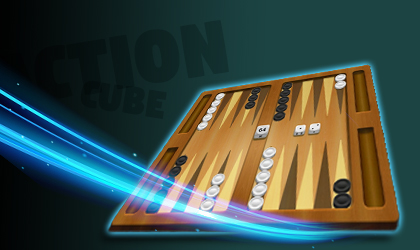 - Duplicate backgammon is a style of tournament backgammon play where competitors play games using the same dice rolls and compare the results.
- Duplicate backgammon is a style of tournament backgammon play where competitors play games using the same dice rolls and compare the results.
Duplicate Dice
- Duplicate dice is a technique of rolling out the same random dice rolls for two or more positions to compare the results.
Duplicate Tournament
- Duplicate tournament is the same as duplicate backgammon which a tournament in which players play their games using the same dice rolls and compare the outcomes.
Duplication
- Duplication is backgammon lingo meaning a position in which the same number can be used in multiple ways.
Dutch Backgammon
- Dutch backgammon is a variation of backgammon in which the players begin the game with all of their checkers off the board.
Dyscommunication
- Dyscommunication is a term describing the down side or negative impact on a players flexibility that having checkers exactly six points apart has on a game.
Early Game
- Early game is a reference to the first few moves in a backgammon game before the players have established a strategy.
Early to Late Ratio
- The early-late ratio is a way of comparing the cost of doubling before or after an opponents drop point. This is useful in determining what level of aggressiveness is appropriate to maintain your market.
Edge of Prime
- The edge of a prime is an open point directly in front of a prime.
Effective Pip Count
- An effective pip count, or EPC is an average number of dice rolls that are required in order to bear off all of your checkers multiplied by the average pip value of a roll.
Efficient Double
- An efficient double is a double made at exactly the right moment when a player would be correct both ways, accepting it and refusing it.
Eject
- Eject means to leave a backgammon game before it is over in order to avoid losing a gammon or a backgammon.
Elimination Format
- Elimination format is a tournament style where the number of players is halved every round until there is only one player left.
Elo Ratings System
- In 1960, Arpad Elo devised a method of rating for the US Chess Federation called the Elo Rating System and most backgammon ratings systems are based on this system.
EMG Equity
 - EMG Equity or Equivalent to Money Game Equity is cubeful equity used in match play often to compare errors between games. Each single losing game at the current value of the cube is assigned a –1 value while every single winning game at the current value of the doubling cube is assigned a value of +1.
- EMG Equity or Equivalent to Money Game Equity is cubeful equity used in match play often to compare errors between games. Each single losing game at the current value of the cube is assigned a –1 value while every single winning game at the current value of the doubling cube is assigned a value of +1.
End Game
- End game is a phase of the backgammon game that starts when the first player begins to bear off their checkers.
Enter
- When a player has been hit, the checker is placed on the bar. That checker must then be entered back onto the board.
Equity
- Equity, simply put, is the value a particular position to a player in a backgammon game. There are several kinds of equity such as Equivalent to Money Game Equity, Cubeless Equity, Cubeful Equity and Match Equity.
Error Rate
- The error rate for a backgammon player is a way of measuring on average, the equity lost per move because of errors in game play.
Escape
- Escape in backgammon means to move your checker past an opponents blockade to safety.
Establish a Point
- Establish a point means the same thing as make a point which is to place two or more checkers on a point thus securing that point.
Eureka
- Eureka or Eureika is a simplified variation of backgammon in which the players start with only two checkers on the one, two and three points and three checkers on the four, five and six point.
Exposed Checker
- An exposed checker is a players checker that is within range of being hit directly.
Extras
- Extras is a reference in backgammon to mandatory extras which is an optional rule for both money play and chouettes.
Fan
- Fan is the same as dance and is to fail at rolling numbers on the dice from the bar that will allow you to enter the board.
Fast Board
- Fast Board is a backgammon reference that means the same as speed board and that is when a player has all of their checkers crowded into the first three points of their home board expecting to remove two checkers with every roll.
Favorite
- The favorite in a game of backgammon is the player that is most likely to win the game.
FIBS
- FIBS is short for First Internet Backgammon Server which is a forum on the internet where one can play backgammon with other backgammon players from all over the world.
FIBS Rating
- The FIBS Rating is a system for ranking a backgammon playe according to their skill. The FIBS Rating system works by assigning each backgammon player a number (starts at 1500) and adding and subtracting to it based on wins and losses with other FIBS Rated players.
FIBS Rating Formula
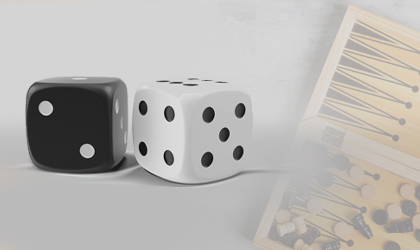 - The FIBS Rating Formula is the backgammon player ratings system used to rank backgammon players by skill level on the First Internet Backgammon Server.
- The FIBS Rating Formula is the backgammon player ratings system used to rank backgammon players by skill level on the First Internet Backgammon Server.
Field Goal
- A field goal is a reference in backgammon play when a player has two direct hits within two spaces of each other and rolls an number on the dice that lands between them.
Fischer Clock
- A Fischer clock is a type of chess clock. The Fischer clock, while being suitable for backgammon play, is not as good as a digital clock which has a time delay feature.
Five Point
- The five point is the fifth point in a players home board. The five point is strategically a powerful point to occupy in a backgammon game.
On This Page



